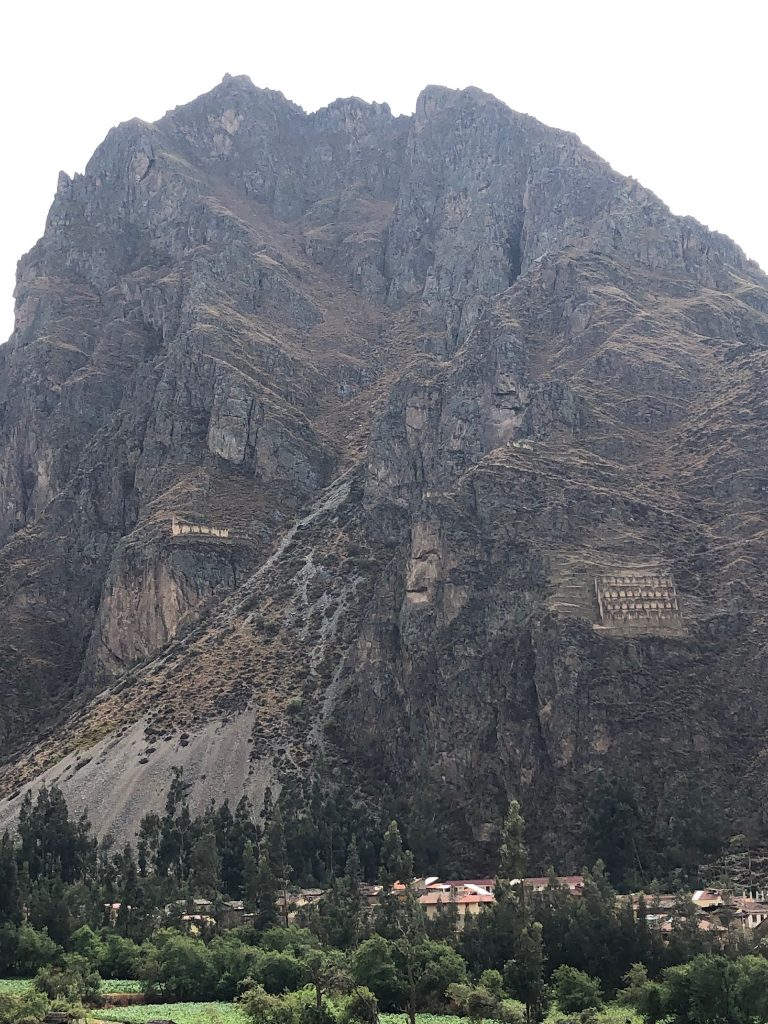One of the reasons I chose this specific tour to get to Machu Picchu over the many others is that it offered some options each day, so you could tailor the hikes to your level and your body’s ability, and the chance to learn more about the history and region and culture, rather than just come here to hike and see the tourist destination that is Machu Picchu. And I feel like all the hikes and stops and archeological sites we’ve visited have prepared us for the splendor that is Machu Picchu.
As an example, we spent the morning at Ollantaytambo, an amazing example of the architecture, agriculture, ingenuity and spiritually of the Incan people. The stones that built the terraces and the Temple of the Sun, and the store houses and the ceremonial baths were all dragged from a quarry at the top of the adjacent mountain, down a steep ramp, and then up to the the top, where they were fitted with precision into walls and houses and temples. Primarily pink granite, it was cut to specifications based on the architects’ direction, and then slowly and methodically delivered to the site chosen by the Incan king at the time. This site sits at the end of the Ollantaytambo valley, which runs for almost 200 miles, and was glacier-formed. To ensure that their food stores weren’t destroyed in what they believed might be future glacier events, all the store houses were placed high up on the hillsides.
Big believers in signs and omens, the site was positioned so that at the solstices, the sun would shine on specific places, and the resting areas and thrones were all positioned to face the east and the sun rise. The people had a deep belief system rooted in their Andean religion, and most of the design decisions that they made were based on those beliefs. In addition, the high vantage point proved useful during both the Incan civil wars, and the subsequent Spanish invasions. The site is almost all original and incredibly impressive and along with Machu Picchu and Sacsayhuaman form three of the most important examples of Incan development in Peru.
After that sunny morning visit, we boarded the train for the 90 minute trip to the northwest towards Machu Picchu. The weather changed and the trees became more tropical as we entered the tropical rain forest. The mountain peaks were hidden in the mist and suddenly it felt like we were entering a new place. When the train dropped us in Aguas Calientes, we then had a 25 minute bus ride up a steep mountain, along switch backs, to finally arrive at the gates to Machu Picchu. The weather gods did not cooperate for just as we got off the bus it began to rain so we quickly got geared up for a wet tour. It didn’t last too long, and it certainly didn’t detract from the amazing views and experience. Our guide, Fernando, is so good, and has been here so many times, that he could expertly tell us the important bits of information about each structure.
Highlights for me were the Temple of the Sun, the only round structure in the complex, and understanding how the challenging aqueduct system was critical to the longevity of the entire city. The one area that seems to have collapsed apparently has done so because the irrigation system didn’t funnel the water in the correct way and forced the land below the walls and building to fall into disrepair. The foundation alone for this city and the ceremonial and agricultural terraces took years to build properly.
There were llama strolling the grounds, which I found particularly charming, and we found some chinchillas, a cross between a rabbit and a squirrel hanging out in the trapezoidal naves in one temple near the top. We also learned that one U.S. scientist undertook an experiment in carving the white granite, making a stone of a particular size to see how long it took. Then he counted all the stones in MP and determined that it would have taken several generations to get the city to the state in which it was finally discovered. Machu Picchu was never finished or lived in for any length of time; the assumption is that the workers believed they would come back to complete it within a few years, but instead the forest took over. Machu Picchu wasn’t really discovered until the early 1900’s.
We will go back tomorrow and take some hikes up to viewpoints; keeping fingers crossed for clear skies.




















I could live there! The stone work is just incredible.
WOW!!!